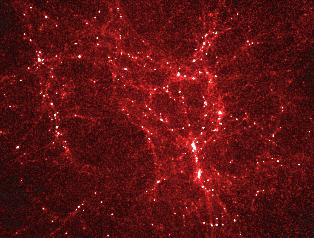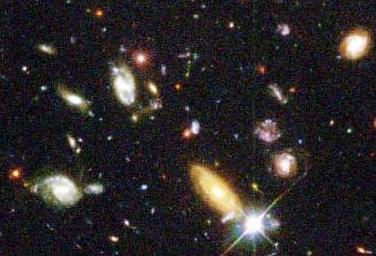How Did Current Structures form from the Smooth
Cosmic Background Radiation?
|
This is a
computer simulation showing early structures which
collapsed out of the rather smooth initial universe. The
filamentary like structures also resemble "bubbles". These
simulations try to match the kinds of structures seen in
large scale galaxy surveys which show such bubbles or voids
between large sheet-like structures of galaxies and galaxy clusters.
The brightest dots in this simulation are called galaxy seeds.
Click HERE for a movie showing the development of such structures from an initially very smooth mass distribution. |

|

|
The density of matter in the region of space that now contains the Milky Way was perhaps 0.5% higher than in adjacent regions. Because its density was higher, this region of space expanded more slowly than surrounding regions. As a result of this slower expansion, its relative over-density grew. After a billion years of this slow expansion, our region of space was roughly twice the density of neighboring regions. This, about 1 billion years after the Big Bang, was the time in which galaxies formed, as seen in the most distant HST Deep Field. |
Inflation theory to the rescue again!
Subatomic quantum fluctuations would be stretched by inflation to
create subtle, but large scale density variations. Later in the
history of the Universe these density
fluctuations can help provide seeds to cause matter to begin
to clump together to form the galaxies and
other observed structures we see today.